Scottish Sea Fisheries Statistics 2012
A detailed overview of landings of sea fish; the Scottish fishing fleet; and the number of sea fishermen employed.
2. The Scottish fishing fleet
This chapter brings together information on the Scottish fleet structure, fishing effort by the Scottish fleet, and the number of fishermen employed in Scotland. A summary of how the UK fleet is regulated is provided to assist interpretation of the statistics.
2.1 Regulation of the UK fleet
UK fishing vessels engaged in commercial sea fishing are required by law to be registered with the Registry of Shipping and Seamen ( RSS), part of the Maritime and Coastguard Agency. To fish commercially, fishing vessels must also have a licence which specifies conditions that must be adhered to when fishing activity is being pursued. For the purpose of this statistical bulletin, active vessels are those which are both registered and licensed as of 31st December of the year of reference. Scottish based vessels are those registered to a port in Scotland licensed at and administered by a Scottish district.
UK fishing vessel licences authorise the sea areas in which a vessel can fish and the species of fish that can be retained on-board. Restrictive licensing was introduced in 1983 following agreement of the Common Fisheries Policy ( CFP) by the European Commission and has been used as the main tool to control UK fishing capacity to meet the European Union regulations for sustainable fisheries management. Initially, the licensing regime only covered vessels of over ten metres registered length and fishing for a number of designated species in specific areas. The coverage of licences has progressively extended over the years to cover all species if fished commercially and both the over ten metre fleet and ten metres and under fleet. The capacity of fishing vessels in terms of vessel tonnage and power is also controlled through licences. With a finite number of licences in existence and no new licences made available, this places a ceiling on the total number and capacity of vessels in the UK fishing fleet. In order to licence new vessels, fishermen must acquire one or more existing licences from other previously licensed vessels. When licences are transferred, or aggregated to form a larger licence unit, capacity penalties are applied. These capacity penalties together with the restricted number of licences on issue form a mechanism resulting in reductions in the capacity of the UK fleet. Further reductions in the capacity of the UK fleet have resulted from successive decommissioning schemes. Designed to conserve vulnerable whitefish stocks, particularly cod, decommissioning removed vessels from the fleet in 1994-1997, 2001-2002 and 2003-2004.
2.2 Size of the Scottish fleet
The number of active Scottish based vessels has fallen to 2,046 vessels in 2012. This is the smallest recorded number and 49 vessels less than in 2011. It is a 12 per cent decrease (291 vessels) compared to ten years ago (2002).
The total power of the Scottish fleet has decreased to 380 thousand kW, down two per cent since last year. Figures in earlier years have been underestimated to an unknown degree due to under declaration of engine power on vessels' licences. Therefore, year on year power comparisons involving earlier years should be made with caution. A concessionary licensing arrangement and a timetable for compliance were introduced in 1999 and vessel owners had until the end of 2004 to declare the true engine power. Comparisons on vessel capacity (tonnage) are also complicated due to revisions in the measurement methodology. Various national and international standards collectively known as gross registered tonnage ( GRT) were revised to a common EU standard known as gross tonnage ( GT). A phased programme of re-measurement was introduced in the UK in 1996 and completed by early 2004. In Charts 2.1 revisions are noted with an 'r'.
Chart 2.1 Size of the Scottish fleet: 2003 to 2012.
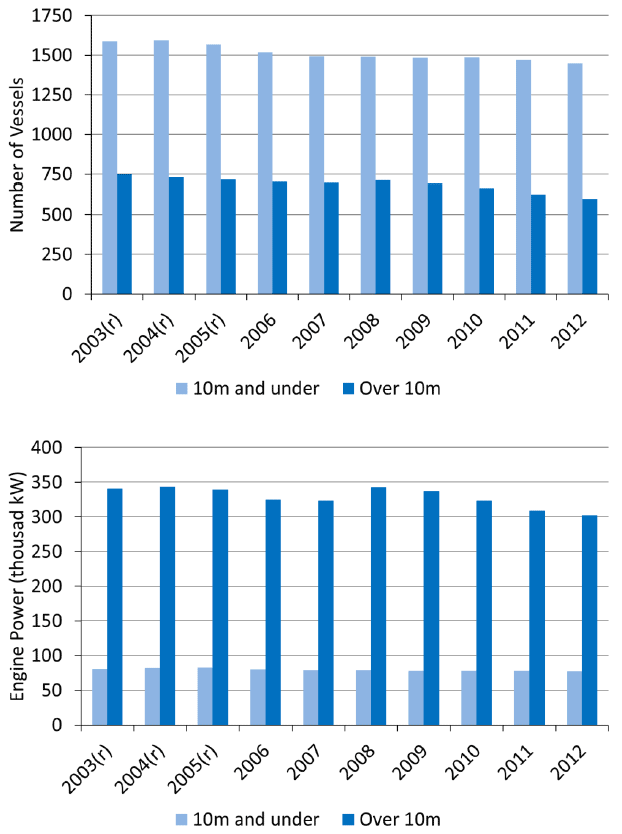
2.2.1 Size of the Scottish fleet by length
In numbers the Scottish fleet is dominated by vessels with a length of ten metres and under, with 1,448 vessels in 2012 accounting for 71 per cent of the Scottish fleet, while the over ten metre fleet comprises 598 vessels. In contrast, the over ten metre fleet holds 80 per cent of the total power of the Scottish fleet. The average power per vessel for the over ten metre fleet was 505 kW in 2012, whereas for the ten metre and under fleet, it was 54 kW. Compared to 2005, the first year by which owners declared their true engine power, average power has seen little change in the ten metre and under fleet (a two per cent increase) but in the over ten metre fleet the average power per vessel has risen by seven per cent. This increase in average power for an individual vessel occurs against the general trend of decreasing vessel numbers and aggregated fleet power.
As well as providing figures for the number, capacity and power of the over ten metre and ten metre and under fleets, figures are given for revised length categories. The revisions to the length categories aim to reflect length categorisation used in specific regulation and licensing conditions. The current quota and effort regulations make a distinction between the ten metre and under, and over ten metre fleets, while the electronic reporting and recording system ( ERS), introduced in 2010, has a staggered adoption based on vessel length. The ERS adoption length groups are; vessels of 24m and over, 15-24m and 12-15m. An additional categorisation used for 24m and over vessels is 24m-40m, and over 40m, to align with the length categories used in the widely recognised Seafish fleet segmentation criteria.
2.2.2 Size of the Scottish fleet by age
Over two thirds of the Scottish fleet of known age are at least 20 years old, with an average age of 25. Vessels under ten years accounted for 11 per cent of the total fleet in number but 30 per cent of the total power of the Scottish fleet, substantially more than any other age category. Vessels aged ten years and under, and of a length over 40 metres, accounted for 22 per cent of the total power of the Scottish fleet, highlighting the large amount of power the young, large vessels have.
Chart 2.2 Size, capacity and power of the Scottish fleet by age: 2012.
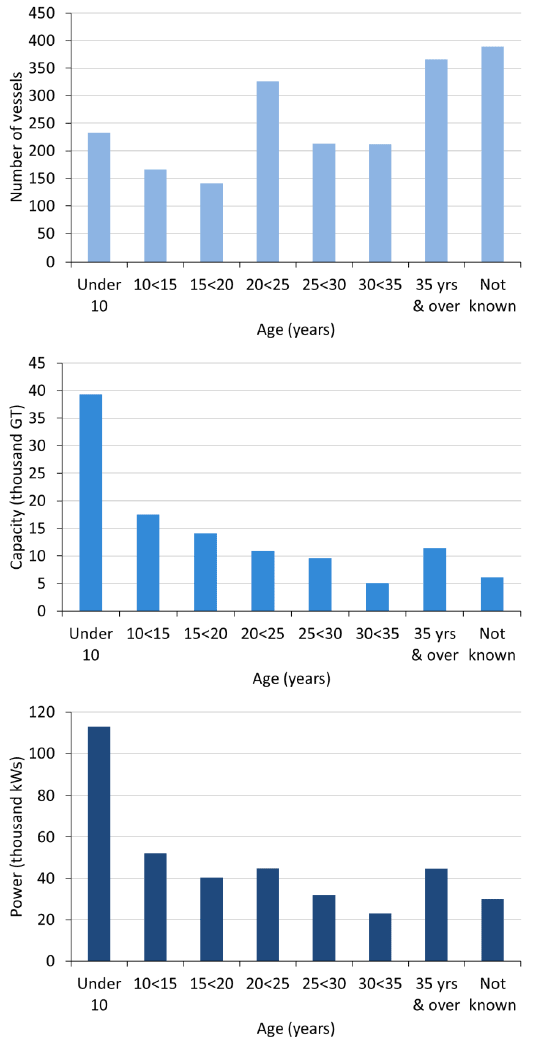
2.2.3 Size of the Scottish fleet by administration district
Figure 2.1 shows the number of vessels in each of the eighteen administration districts in Scotland. Stornoway and Fraserburgh are the two largest districts in terms of vessel number with 20 per cent of Scottish vessels in these districts. In 2012, there were 215 vessels under the responsibility of Stornoway and 202 vessels under the responsibility of Fraserburgh. Over three quarters of the vessels in the Stornoway district were in the ten metre and under category. Within the Fraserburgh administration district half the vessels were ten metres and under in length. Both Ayr and Peterhead also had nearly equal proportions of over ten metre and ten metre and under vessels. Other districts have far more ten metre and under vessels than over ten metre vessels.
2.2.4 Size of the Scottish fleet by fishing method
The ten metre and under fleet is dominated by vessels using creel fishing, namely traps in the form of cages or baskets, typically baited and used to target shellfish species. In 2012, 87 per cent of the 1,448 ten metre and under vessels were creel fishing. Of the 598 over ten metre vessels, 60 per cent were shellfish vessels whilst 36 per cent were demersal. Only 24 vessels were pelagic, all of which are over 40 metres in length. Creel fishing and Nephrops trawls dominate the over ten metre shellfish group whilst trawlers dominate the demersal group. Twenty of the pelagic vessels are pelagic trawlers and the rest are purse seiners.
Figure 2.1 Number of vessel in the Scottish fleet by district: 2012.
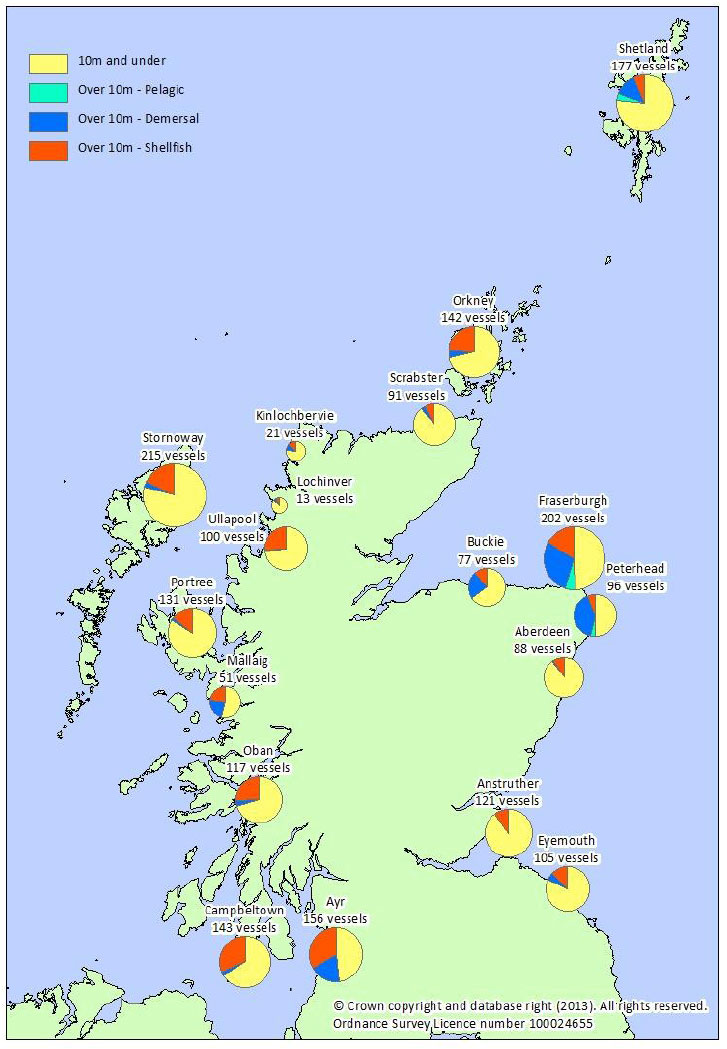
2.3 Effort in the Cod Recovery Zone
The Cod Recovery Zone ( CRZ) is sea areas in which restrictions exist on fishing effort by vessels over ten metres using certain regulated gears. A map of the areas covered by the CRZ is given in Annex 6. These measures aim to reduce cod mortality and encourage recovery of the vulnerable cod stocks. Introduced in February 2003, the CRZ covered specified gears that catch considerable amounts of cod in the North Sea and the West of Scotland. The regime was expanded in 2004 to include the Irish Sea. Eight regulated gears were specified, as detailed in the glossary, and the effort of Scottish vessels using these regulated gears are presented in Table 2.7. Please note that the figures are presented for the calendar year although the annual effort control measures cover a twelve month period from 1 February to 31 January.
Trends for the two most cod-intensive gear grouping Whitefish ( TR1) and Nephrops ( TR2) that dominate the effort by the Scottish over ten metre fleet are discussed by sea area in each of the paragraphs below. Whitefish ( TR1) gears include bottom trawls and seines of mesh size greater or equal to 100 mm, and these gears typically target whitefish, including cod. The Nephrops ( TR2) gear type includes bottom trawls and seines of mesh size greater than or equal to 70 mm and less than 100 mm, and typically target Nephrops, but also catch considerable amounts of cod.
In 2012, effort using whitefish ( TR1) and Nephrops ( TR2) in the North Sea reached 9.3 million kW days and 5.3 million kW days respectively ( Table 2.7 and Chart 2.3). In comparison to 2011, effort for whitefish ( TR1) gears fell seven per cent in the North Sea whilst effort for Nephrops ( TR2) gears fell 22 per cent, a reflection on the poor Nephrops availability in the Fladens, North Sea. In the most recent years, effort uptake of TR2 gears decreased in the North Sea. This followed a fairly stable period of seven years in terms of TR2 effort uptake. Whitefish ( TR1) effort declined significantly between 2000 and 2004, partially as a result of decommissioning schemes, and since then has been fairly stable.
Effort in the West of Scotland continues to be much lower than in the North Sea. Whitefish ( TR1) gears had an effort uptake of 2.1 million kW days in the West of Scotland, similar to that of 2011. Effort for Nephrops ( TR2) gears reached 4.4 million kW days, an increase of 23 per cent from 2011. The increase of TR2 effort in the West of Scotland was the result of vessels which target Nephrops switching from effort in the North Sea to the West coast as a result of the Nephrops shortage in the Fladens. Prior to 2012, Nephrops ( TR2) effort in the West of Scotland had shown a general downwards trend since 2003. Whitefish ( TR1) effort dropped by 69 per cent between 2001 and 2005, predominantly due to the reduction in fleet capacity following decommissioning schemes, but has been broadly stable from 2006 onwards.
Chart 2.3 Effort of Scottish vessels using whitefish ( TR1) gear and Nephrops ( TR2) gear in the Cod recovery Zone: 2000 to 2012.
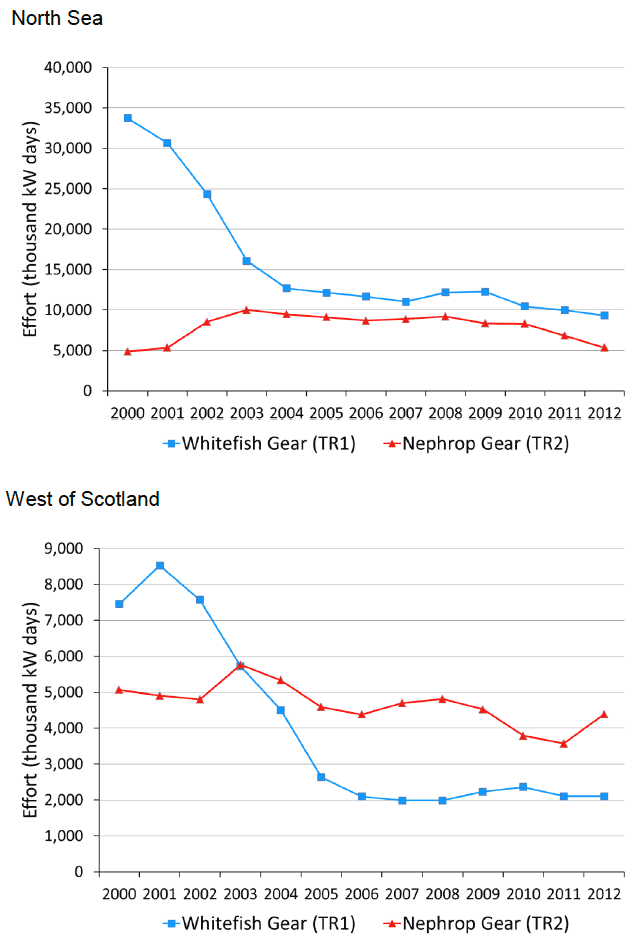
2.4 Number of fishermen
In 2012, 4,747 fishermen were employed on Scottish based vessels, representing 0.2 per cent of the total Scottish labour force. The number of fishermen employed on Scottish vessels fell five per cent (249 persons) from 2011 to 2012 ( Table 2.8 and Chart 2.4). This decrease was driven by a fall of eight per cent (315 persons) in those who are regularly employed but the effect of this was buffered by a seven per cent increase (64 persons) in those who are irregularly employed. In addition to regularly and irregularly employed fishermen, Scotland has a small number of crofters that engage in commercial fishing. A crofter is a person who occupies and works a small land-holding known as a croft and operates a system of small-scale subsistence farming. There were 54 crofters engaged in commercial fishing in 2012, two more than in 2011. Since 1970, employment on Scottish based fishing vessels has fallen 49 per cent, with large decreases in each employment category - 51 per cent in regular employment, 35 per cent in irregular employment and 80 per cent in the number of crofters engaged in commercial fishing. These decreases in fishermen numbers could be attributed to reductions in fleet capacity and increased vessel efficiency.
Fraserburgh is the district with the largest number of fishermen. At 797 fishermen in total, Fraserburgh accounted for 17 per cent of the total number of fishermen on Scottish vessels in 2012. Shetland, with 201 irregularly employed fishermen, is the district with the largest number of fishermen who work irregularly. No irregularly employed fishermen are found on vessels administered by Scrabster, Kinlochbervie and Oban districts. Portree, Stornoway, Lochinver and Kinlochbervie were the only districts with crofters.
Chart 2.4 Number of fishermen employed on Scottish based vessels: 1970 to 2012.
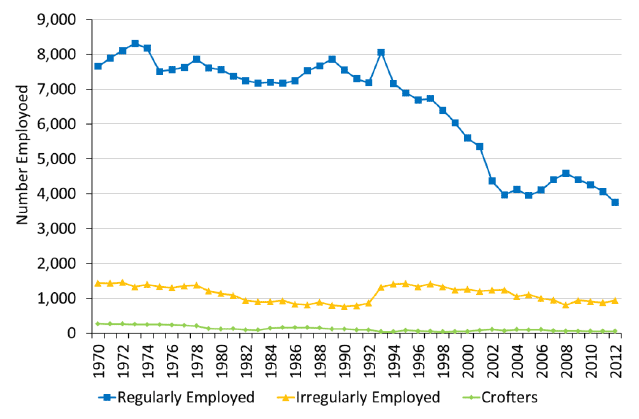
Contact
There is a problem
Thanks for your feedback